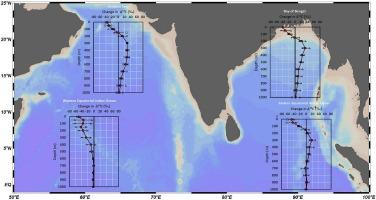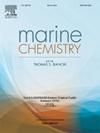Bomb-radiocarbon in the Northern Indian Ocean
IF 3
3区 地球科学
Q2 CHEMISTRY, MULTIDISCIPLINARY
引用次数: 0
Abstract
Bomb-radiocarbon is a useful tracer to study ocean circulation and air-sea CO2 exchange processes. In the present study bomb radiocarbon distribution in dissolved inorganic carbon of the Northern Indian Ocean around late 2010s has been evaluated. In the late 2010s surface waters in the Northern Indian Ocean had ∆14C values ranging between 9 and 17 ‰ which is comparable or even higher than that of the contemporaneous atmospheric ∆14C values. Water column measurements showed that the bomb 14C inventory in the Arabian Sea and the Bay of Bengal has increased between 1990s and 2010s. During the same period, the eastern and western equatorial Indian Ocean showed either no change or a slight decline in the water column bomb 14C inventory. These bomb 14C inventory values were also used to estimate the air-sea CO2 exchange rate and net CO2 flux over the Northern Indian Ocean region. Bomb 14C-based estimate of net CO2 flux from the Arabian Sea is 75 ± 24 Tg C yr−1 and the Bay of Bengal is 1 ± 7 Tg C yr−1, which is comparable to the estimates reported by previous investigations in the region. The present observations show that the bomb 14C is being transferred to the deeper depths of the ocean, emphasizing the need for continued 14C measurements to gain further insights into subsurface processes in the region.

北印度洋的炸弹-放射性碳
炸弹放射性碳是研究海洋环流和海气二氧化碳交换过程的有用示踪剂。本研究对 2010 年代末期北印度洋溶解无机碳中的炸弹放射性碳分布进行了评估。2010 年代末,北印度洋表层水的∆14C 值介于 9 至 17 ‰之间,与同期大气∆14C 值相当甚至更高。水柱测量结果表明,阿拉伯海和孟加拉湾的弹 14C 库存在 20 世纪 90 年代至 2010 年代期间有所增加。同期,赤道印度洋东部和西部的水柱弹 14C 库存量没有变化或略有下降。这些炸弹 14C 列表值还被用于估算北印度洋地区的海气二氧化碳交换率和二氧化碳净通量。基于炸弹 14C 估算的阿拉伯海二氧化碳净通量为 75 ± 24 Tg C yr-1,孟加拉湾为 1 ± 7 Tg C yr-1,与该地区以往调查报告的估算值相当。目前的观测结果表明,炸弹中的 14C 正在向海洋深处转移,这强调了继续进行 14C 测量以进一步了解该地区次表层过程的必要性。
本文章由计算机程序翻译,如有差异,请以英文原文为准。
求助全文
约1分钟内获得全文
求助全文
来源期刊

Marine Chemistry
化学-海洋学
CiteScore
6.00
自引率
3.30%
发文量
70
审稿时长
4.5 months
期刊介绍:
Marine Chemistry is an international medium for the publication of original studies and occasional reviews in the field of chemistry in the marine environment, with emphasis on the dynamic approach. The journal endeavours to cover all aspects, from chemical processes to theoretical and experimental work, and, by providing a central channel of communication, to speed the flow of information in this relatively new and rapidly expanding discipline.
 求助内容:
求助内容: 应助结果提醒方式:
应助结果提醒方式:


